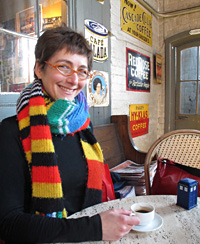The pattern for the scarf suggests 2.5mm needles with the Noro Sekku.
The question:
I've got the pattern and I have the yarn! But... I need to purchase the needles and am confused. You have 2.5 mm listed. I get this warning when trying to order (Watch those US sizes! Addi calls their 2.5mm needle a US#1, but Inox calls their 2.5mm needle a US#2.) So which did YOU use.. US#1 or US#2I'm going to sound insane when I say this, but I used 2.5mm needles. Really. You're right, the problem is that there isn't an agreed-upon conversion for the 2.5mm size. At Knitty, we tend to refer to it as US Size #1.5. Most needle size conversion tables (a handy one can be found at yarnstandards.com)list US #1 as 2.25mm metric, and US #2 as 2.75mm metric, and then you get all sorts of nonsense going on for 2.5mm. Some brands and companies stick to the US sizing, which means that a 2.5mm can't be had.
Also, which US# for the casting off 3.5 mm needle?
Now, both Addi and Inox needles are manufactured in metric sizes, being European brands, so it this case, it actually doesn't matter what they say the US size is, just make sure you buy on that's labelled at 2.5mm.
And because this is a scarf and gauge doesn't matter all that much, if you really can't find an actual 2.5mm needle, go with a US #2/2.75. The fabric will be a bit looser and drapier, but that's not a bad thing.
As for casting off, I tend to use a larger needle for casting off to ensure a flexible edge. I've recommended at 3.5mm, which is listed without much disagreement as a US #4. Hope this helps! If you can't find one of those, a 3.75mm/US 5 will work just as well.






2 comments:
Enough with the numerals. Let's get metric! Measurements are standard and easy to communicate internationally. (And that trick about going up a size or two to cast off is magic. Magic!)
I wish all needles would just advertise their metric size and get rid of the # designation. Don't know how many times I look at a pattern calling for needle size US # or British # and have to find a needle conversion chart to tell me the size,or worse try to read the tiny tiny id stamped on the side of the needle. Can you tell - its a pet peeve of mine... makes me crazy
Post a Comment